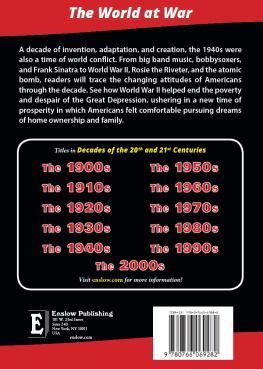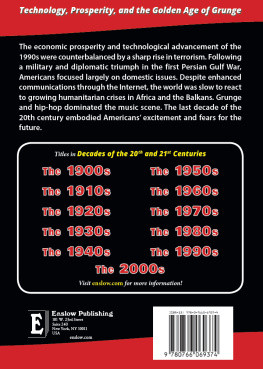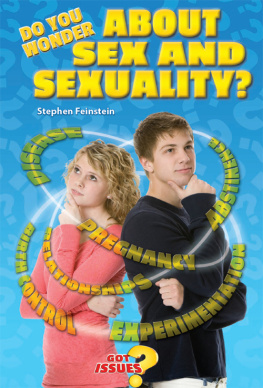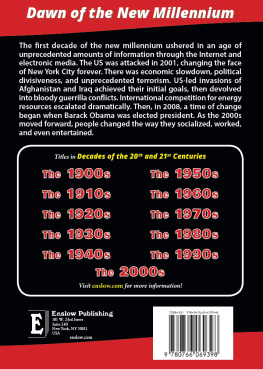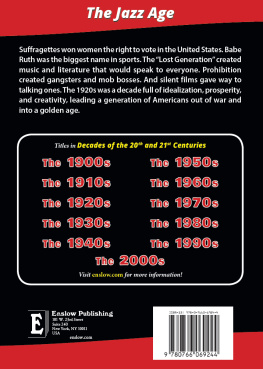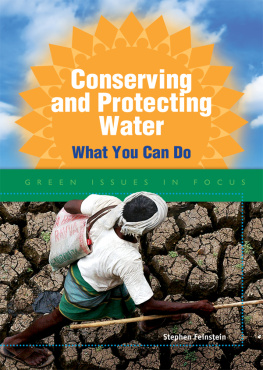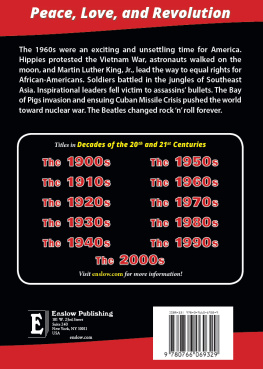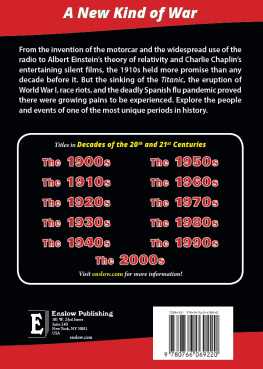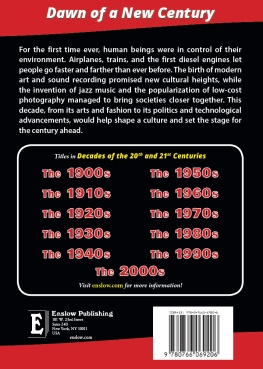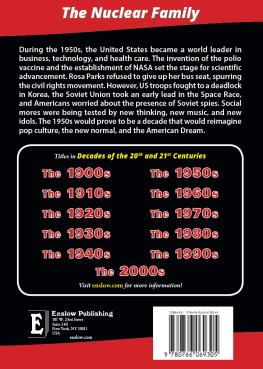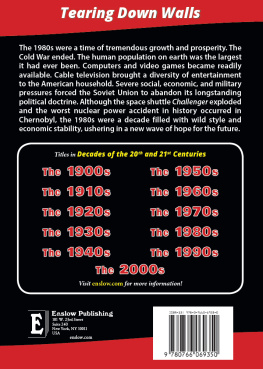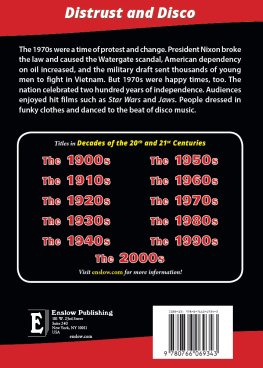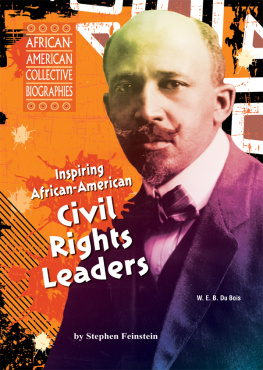Stephen Feinstein - The 1940s
Here you can read online Stephen Feinstein - The 1940s full text of the book (entire story) in english for free. Download pdf and epub, get meaning, cover and reviews about this ebook. publisher: Enslow Publishing, genre: History. Description of the work, (preface) as well as reviews are available. Best literature library LitArk.com created for fans of good reading and offers a wide selection of genres:
Romance novel
Science fiction
Adventure
Detective
Science
History
Home and family
Prose
Art
Politics
Computer
Non-fiction
Religion
Business
Children
Humor
Choose a favorite category and find really read worthwhile books. Enjoy immersion in the world of imagination, feel the emotions of the characters or learn something new for yourself, make an fascinating discovery.
- Book:The 1940s
- Author:
- Publisher:Enslow Publishing
- Genre:
- Rating:5 / 5
- Favourites:Add to favourites
- Your mark:
- 100
- 1
- 2
- 3
- 4
- 5
The 1940s: summary, description and annotation
We offer to read an annotation, description, summary or preface (depends on what the author of the book "The 1940s" wrote himself). If you haven't found the necessary information about the book — write in the comments, we will try to find it.
The 1940s — read online for free the complete book (whole text) full work
Below is the text of the book, divided by pages. System saving the place of the last page read, allows you to conveniently read the book "The 1940s" online for free, without having to search again every time where you left off. Put a bookmark, and you can go to the page where you finished reading at any time.
Font size:
Interval:
Bookmark:


Published in 2016 by Enslow Publishing, LLC.
101 W. 23rd Street, Suite 240, New York, NY 10011
Copyright 2016 by Enslow Publishing, LLC.
All rights reserved.
No part of this book may be reproduced by any means without the written permission of the publisher.
Library of Congress Cataloging-in-Publication Data
Feinstein, Stephen.
The 1940s / Stephen Feinstein.
pages cm. (Decades of the 20th and 21st centuries)
Includes bibliographical references and index.
Summary: Discusses the decade 1940-1949 in the United States in terms of culture, art, science, and politicsProvided by publisher.
Audience: Grade 9 to 12.
ISBN 978-0-7660-6928-2
1. United StatesCivilization1918-1945Juvenile literature. 2. United StatesCivilization1945Juvenile literature. 3. United StatesPolitics and government1933-1945Juvenile literature. 4. United StatesPolitics and government1945-1953Juvenile literature. 5. Nineteen forties Juvenile literature. I. Title.
E169.1.F356 2015
973.918dc23
2015010946
Printed in the United States of America
To Our Readers: We have done our best to make sure all Web sites in this book were active and appropriate when we went to press. However, the author and the publisher have no control over and assume no liability for the material available on those Web sites or on any Web sites they may link to. Any comments or suggestions can be sent by e-mail to .
Photo Credits: AFP/Getty Images, p..
Cover Credits: CPHoM Robert F. Sargent/National Archives and Records/Into the Jaws of Death/public domain (D-Day); Jewish Chronicle/Heritage Images/Getty Images (Anne Frank); Photo File/MLB Photos via Getty Images (Jackie Robinson); TinaImages/Shutterstock.com (Rosie the Riveter).
Contents
Introduction
Pop Culture, Lifestyles, and Fashion
Entertainment and the Arts
Sports
National and International Politics
Advances in Science, Technology, and Medicine
Conclusion
Timeline
Glossary
Further Reading
Index

The attack on Pearl Harbor brought America into World War II.
Introduction
The 1930s were difficult years for most Americans. Millions had to endure extreme poverty and hunger during the Great Depression, an economic collapse that affected the whole world. Under President Franklin D. Roosevelt, the nation pulled out of the depths of the Depression. But the economy was still weak, and many Americans remained unemployed.
As the 1940s began, Americans hoped for an improvement in their livesbetter job opportunities and financial security. Although much of the world was at war, Americans were more concerned with domestic matters. In fact, most thought isolationismavoiding involvement in conflicts abroadwas the best policy for America. As bad as things seemed overseas, the problems there did not seem to concern America. When Roosevelt ran for an unprecedented third term as president in 1940, he told Americans that he would not send their sons to fight overseas. This was what Americans wanted to hear. They voted Roosevelt into office again.
On December 7, 1941, Japan carried out a surprise air attack on the US naval base at Pearl Harbor, Hawaii. By December 11, the United States was at war. By its end in 1945, the war would change the United States, its economy, and the decade of the 1940s in dramatic ways. By far, World War II was the biggest event of the decade and the worst conflict in human history. Roughly sixty million people died in the war. At least half of the wars victims were civilians. Some were bystanders killed in by bombs and shelling. Others were victims of disease and starvation. Still others were executed because of their race or religion.
World War II officially began on September 1, 1939, when Nazi Germany invaded Poland. Germany had fallen into a dire economic crisis. Its citizens were unemployed and starving. Many Germans fell under the spell of charismatic leader Adolf Hitler. Hitler built his Nazi Party using fear and hate, but he also promised full recovery of Germany. The German people became fully devoted to him. Hitlers plan for economic recovery had Germans building tanks, airplanes, and submarines to create a strong military. Soon, Hitler was using it to threaten nearby nations.
A similar problem was developing in Japan. The military ran the nation and demanded absolute loyalty from the Japanese people. Before long, Japan was also threatening its neighbors with its war weapons. In 1937, it launched a full-scale invasion of China. Japanese troops also seized other land in Asia and the Pacific Ocean. These acts created fierce tension between Japan and the United States.
By the end of 1941, every major nation in the world was at war. Germany, Japan, and Italy banded together to form the Axis powers. Those who opposed them were known as the Allies, led by Great Britain, the Soviet Union, and the United States. Before the war ended in 1945, more than sixty countries had taken part.
World War II changed America in many ways. With millions of men overseas, women made up a larger part of the workforce. About three million women took factory jobs. They showed that they could do the same work as men. African Americans also stepped forward. They fought bravely even though their country treated them as second-class citizens. When the war was over, many women and African Americans were unwilling to return to a lesser position in American society. World War II caused many other important changes. It affected American business, sports, and the arts.
Pop Culture, Lifestyles, and Fashion
Americans were used to buying whatever they wanted whenever they wantedif they had enough money to make the purchase. Once the United States entered World War II, people were suddenly faced with restrictions on what and how much they could buy.
Patriotism and Rationing
On December 27, 1941, the government announced a rationing of rubber tires. A rubber shortage had come about almost overnight. There was a shortage of gasoline during the war, as well. The military needed it for jeeps, tanks, planes, and ships. As a result, there was little gas left over for civilians to put in their cars. The government gave out ration coupons. These coupons enabled each family to buy a small amount of gas each week. Rationing ensured that everyone received a fair share.
Soon the new federal Office of Price Administration (OPA) announced that various other goods would also be strictly rationed, including sugar, coffee, meat, fats and oils, cheese, and shoes. The OPA also issued books of ration stamps, which had to be used to buy rationed goods. Americans had no choice but to go along with the OPAs rationing system. Surprisingly, Americans ate better during the war years than they did during the 1930s. Even though many food products were strictly rationed, the need for factories to produce huge amounts of goods for fighting the war meant that most people had jobs. They could afford to buy more of whatever was available.

Americans grew victory gardens to help the nations food supply.
Font size:
Interval:
Bookmark:
Similar books «The 1940s»
Look at similar books to The 1940s. We have selected literature similar in name and meaning in the hope of providing readers with more options to find new, interesting, not yet read works.
Discussion, reviews of the book The 1940s and just readers' own opinions. Leave your comments, write what you think about the work, its meaning or the main characters. Specify what exactly you liked and what you didn't like, and why you think so.

